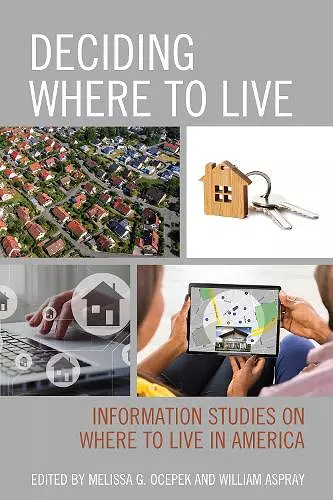Deciding Where to Live
Information Studies on Where to Live in America
William Aspray editor Melissa G Ocepek editor
Format:Paperback
Publisher:Rowman & Littlefield
Published:5th Apr '23
Should be back in stock very soon
This paperback is available in another edition too:
- Hardback£97.00(9781538139691)

Deciding Where to Live: Information Studies on Where to Live in America explores major themes related to where to live in America, not only about the acquisition of a home but also the ways in which where one lives relates to one’s cultural identity. It shows how changes in media and information technology are shaping both our housing choices and our understanding of the meaning of personal place. The work is written using widely accessible language but supported by a strong academic foundation from information studies and other humanities and social science disciplines.
Chapters analyze everyday information behavior related to questions about where to live. The eleven major chapters are:
- Chapter 1: Where to live as an information problem: three contemporary examples
- Chapter 2: Turning in place: Real estate agents and the move from information custodians to information brokers
- Chapter 3: The Evolving Residential Real Estate Information Ecosystem: The Rise of Zillow
- Chapter 4: Privacy, Surveillance, and the “Smart Home”
- Chapter 5: This Old House, Fixer Upper, and Better Homes & Gardens: The Housing Crisis and Media Sources
- Chapter 6: A Community Responds to Growth: An Information Story About What Makes for a Good Place to Live."
- Chapter 7: The Valley Between Us: The meta-hodology of racial segregation in Milwaukee, Wisconsin
- Chapter 8: Modeling Hope: Boundary Objects and Design Patterns in a Heartland Heterotopia
- Chapter 9: Home buying in Everyday Life: How Emotion and Time Pressure Shape High Stakes Deciders’ Information Behavior
- Chapter 10: In Search of Home: Examining Information Seeking and Sources That Help African Americans Determine Where to Live
- Chapter 11: Where to Live in Retirement: A Complex Information Problem
While the book is partly about the goal-directed activity of individuals who want to buy a house, and the infrastructure that supports that activity, it is also about personal activities that are either not goal directed or are directed at other goals such as deciding in which geographic location to live, personal entertainment, cultural understanding, or identity formation.
Emphasizing the crucial role of information and information science in vital decisions about "where to live," this complex, well-researched, multifaceted, multi-authored volume provides an exhaustive perspective on the economic and technical aspects of the real estate industry and its historical, demographic, and social-psychological influence. Contributing authors are accomplished researchers and professors specializing in information science at major universities in five states: Colorado, Illinois, Minnesota, New York, and Texas…. Offering much more than a compendium of real estate facts and figures, this edited volume is a unique contribution to the field. The book will be useful to general readers searching for new homes and to real estate specialists and interested academics, including instructors and students.Recommended. All readers.
* Choice Reviews *Deciding Where to Live, edited by William Aspray and Melissa G. Ocepek, comes at a timely moment, as it is a comprehensive guide to some of the more elusive and less recognized aspects of deciding where to call home. . . . As informational as it is thought-provoking, the book compels readers to understand recent shifts in real estate that have been affected by contemporary realities like social media, the internet, and the pandemic. Readers will be drawn not only to the facts and statistics, but also to the cultural and social deep-dives in several of the sections.
* News @ Wesleyan *With such a rich landscape of problems, it is surprising that the informational and emotional dimensions of housing have not been probed before now. In Deciding Where to Live Aspray and Ocepek explore one of life’s central concerns.”--
-- Donald O. Case, Professor Emeritus, University of Kentucky, Author of Looking for Information (2012)Focusing on information behavior in the context of real estate decision-making, this multidisciplinary analysis of information practices in a significant daily life context brings key contemporary issues to the fore, including the pandemic, race, and identity. Students and scholars across a range of disciplines will find this book compelling and illuminating.
-- Heidi Julien, Professor of Information Science, University at BuffaloThe place we choose to live is the single most important decision we make, shaping everything to the kind of jobs and economic opportunity we have access to, the people we meet, date and take as life partners, and the kinds of schools our kids attend. Deciding Where to Live examines the rise of new digital technologies and services that make more and better information available to all of us and enable us to make more informed decisions about where to live. I’m someone who spends far too much time scouring on-line real estate sites like Zillow, Trulia, and Realtor. And this book helped me better understand not just how those technologies that are changing real estate search, but also how they reflect and reinforce underlying structural inequalities of race and class which continue to structure our housing choices and life outcomes.
-- Richard Florida, professor at the Rotman School of Management at the University of Toronto, author of The Rise of the Creative Class, Who’s Your City? and The New Urban Crisis.These detailed accounts of an array of real estate information objects—such as Zillow, HOLC maps, This Old House, and 'smart homes'—offer intriguing insights (e.g., real estate agents as information brokers; emotion, racism, and retirement as influences on home-buying decisions) that are sure to inform future practice and research.
-- Diane E. Bailey, Geri Gay Professor of Communication, Cornell UniverISBN: 9781538183601
Dimensions: 229mm x 151mm x 26mm
Weight: 503g
342 pages